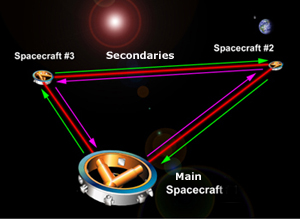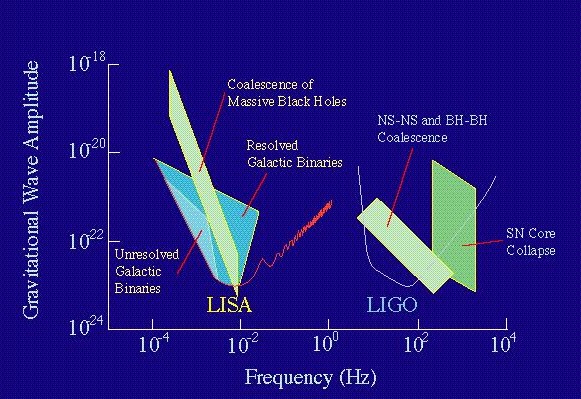Satellite Showcase
LISA
 |
|
Artist's concept of LISA shows the satellite in orbit around the Sun, following about 20 degrees behind the Earth. |
|
The Mission
The Laser Interferometer Space Antenna (LISA) is a next-generation project proposed by NASA to detect some of the weakest (and perhaps most interesting) gravitational waves. Gravitational waves are "ripples in spacetime" caused by large-scale events like galaxy coalescences, black hole collisions, and neutron star binary systems. The project uses the scientific technique of laser interferometry. Three separate spacecraft form three corners of a large triangle in space. Each of the three spacecraft establishes an independent orbit around the Sun, trailing the Earth's orbit by about 20 degrees. When a low-frequency gravitational wave passes, LISA will be able to detect slight changes in the distance between the corners of the triangle. The mission is expected to launch in 2011, with a mission life of about 5 years.
 |
|
LISA's interferometric spacecraft aim and detect laser signals that indicate passing gravitational waves. |
|
How do You Detect Gravitational Waves?
LISA uses a scientific technique called laser interferometry.
Interferometry uses two or more laser 'arms' to detect tiny
fluctuations in distance. Here's how it works: A laser beam from one
of the spacecraft is pointed toward a detector on another spacecraft,
5 million kilometers away. The laser beam precisely measures a
distance between the two spacecraft. When the distance changes, an
interference pattern is formed, and LISA has detected a gravitational
wave. The three arms of the spacecraft work together to confirm each
other's observations, as well as to get more detailed information
about the passing waveform.
Why is LISA so big? The answer is that it has to be big because gravitational waves are so weak. Gravititational waves are essentially propagating strain waves. A strain is a small change in a distance divided by that distance. LISA can measure a change in length approximately 1000 times smaller than the diameter of an atom (or about 30 times the size of the nucleus of an atom!). To measure the very small strains expected for gravitational waves, the distance between spacecraft must be very large - about 5 million km. This is approximately 13 times the distance between the earth and the moon. This observatory will be very sensitive!
On earth scientists can measure distances that are about 1 million times smaller than what LISA can do in space. (One reason for this is that ground-based detectors can use much more powerful lasers.) Therefore, to get the same strain sensitivity, the length of an arm can be 1 million times smaller - or about 5 km. The LIGO project has built such a detector.
The two detectors (LIGO and LISA) complement each other because they
cover different frequency ranges. (See illustration below.) Ground-based detectors cannot see very low frequencies because the ground moves too much (remember - these detectors can see motions that are smaller than the size of atoms). A space-based detector that is free from the motion of the earth is the only way to see low frequencies.
 |
This plot shows the range of
gravitational wave amplitiudes and frequencies that LISA and LIGO will
be sensitive to. Shaded areas show the frequency and amplituded of
gravitational waves given off by different types of objects.
(NS = Neutron Star, BH = Black Hole, SN = Supernova Remnant.)
|
|
Expected Science Results
Once LISA is launched, and starts to return data, scientists will compare it to computer models to interpret what they see. Dr. Joan Centrella and her team of theoretical researchers at NASA are creating what she calls a "numerical laboratory" of models that represent gravitational wave phenomena. Using these waveform computer codes, scientists will be able to decipher LISA's message. They will be able to sift through the information, isolating sources of gravitational waves as well as the behaviors that cause them. The scientists behind the LISA mission hope to detect information about black holes and the Big Bang, as well as proof of Einstein's famous Theory of General Relativity.
See what LISA could tell us about Black Holes, General Relativity, and The Big Bang.
Publication Date: August, 2003
Updated: February, 2006
|
